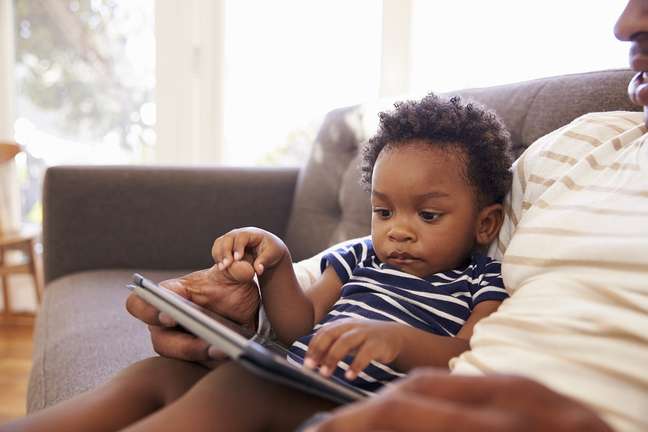The doll is part of a game developed for adults, but it gained popularity and scared children. Find out how to protect them!
“My name is Huggy Wuggy
Sharp teeth make you bleed
never call me ugly

hug me until I die
I know where you are hiding
You’re sliding down the tube
Don’t you know I’ll find you?
wherever you go
In the dark I am waiting
there is no escape
Don’t you know I’m right behind you?
Closer than you think “
It sounds like horror movie music, and in a way it is. But most impressive is that the theme song of Huggy Wuggy, which is a character from an adult game, aimed at an audience aged 14 and over, it has been successful among young children, around the age of 6. Sometimes even less. Not everyone understands, but they end up being impressed by the video clip, which circulates through social networks and open streaming.
the game Poppy play time, which has Huggy Wuggy as its character, tells the story of abandoned and forgotten toys in an empty factory, with a terrifying scenario. The player must go through the corridors without being attacked and killed by the blue soft toy, with a huge mouth full of sharp teeth.
It’s not for kids, but with the Internet and the ease it offers for any type of content to reach any type of person, you have to be careful. In addition to frightening and being violent, the content can generate fear, anguish, anxiety, trauma, disturb sleep …

The risks of the web
But Huggy Wuggy is just the trendy character. There are other dangers on the Internet. In addition to videos, music and games with inappropriate content, there are challenges that can be dangerous to physical and mental health. One of these is the blackout challenge, which consists of suffocating to faint and unconscious, and has already lost the lives of some children and adolescents around the world. “Legends, bad people and useless content have always existed and, unfortunately, will continue to exist. Digital media do nothing but enhance the damage and find a path of access to more easily reach the most vulnerable“, explains the lawyer and specialist in digital law Alessandra Borelli, author of the book Children and adolescents in the digital world: essential guidelines for a safe and conscious use of new technologies (Authentic Publisher).
“Although today’s children are very adept with technological devices, We cannot ignore the fact that, physiologically, they continue to be beings in a peculiar condition of development and, therefore, lacking sufficient discernment and maturity to face certain contents “, Alessandra recalls. “They become insecure and this can generate a series of impacts and losses in development,” she points out.
Maybe your child is still too young to access or even be interested in this type of content, but, The sooner you prepare to address the topic, keep an eye on it and, above all, prepare yourself for this conversation, the greater the chances of creating a space for dialogue and helping the little one to navigate safely. – and supervision – via the Internet. For family psychologist and therapist Cristiane Lima (RJ), this discussion should begin, regardless of age, from the moment the child picks up a mobile or tablet to watch content or play. “The child has begun to lift the mobile phone to play, to have a space to exercise this choice of games and social networks, the dialogue must begin to take place. As long as the child has access, she needs to talk, ”she explains.

controlled access
There is no way around it and you shouldn’t even do it, since children of this generation are constantly influenced by technology. And there are a lot of positives to that too! Being able to access various information and content from anywhere in the world, do research, watch what you want, at any time, talk to loved ones physically distant … What would the world be like during that phase of greater isolation of the pandemic, when the couldn’t children meet their grandparents? Have you ever wondered?
More important than the announcement, it is help your child to navigate, age-appropriate of course, but with limits and, above all, safety. It’s possible to do it? Easy, it’s not, but it’s possible – and essential.
Time limit and rules
The first point is not to leave this navigation free. “Prevention is always the best way”, Alessandra teaches. “Continuous monitoring of children and adolescents in the digital universe is crucialobserving what they access, who they interact with, who their “idols” (digital influencers) are and how these children behave during and after the use of electronics “, he adds.
Furthermore, make possible and healthy combinations, determining times and moments in which the child can use the internet to play and watch the contents. “Anxiety, sleep disturbances, everything your child presents in front of inappropriate content or a game is a consequence of the stimulation time he is given,” recalls Cristiane. The exposure time should be determined according to the age of the child. According to the recommendations of the Brazilian Society of Pediatrics, children under the age of 2 should not be exposed to screens and, for older children, between the ages of 2 and 5, the time should be limited to one hour per day.

you are the example
An important point! There is no need to guide the child not to use the screens or limit the time of use, if you are not the example yourself. Your behavior teaches children a lot more about how to act than your words. “Sometimes we are so tired that it is easier to let our children play or watch TV or videos on the Internet so that we can have a moment of our own, on our social media, instead of paying attention to what really needs to be seen. “recalls Cristiano. The recommendation to be cautious when using the Internet also applies to adults, see?
Safe space and lots of dialogue
Talk to your child, always, about all topics and make sure he always has an open and safe channel to share what he hears are the best ways to prevent damage caused by inappropriate content. “The best way to prepare our children is to create a safe environment for them to express themselves. When they are unable to tell trusted adults what they are feeling, what touched them, what the difficulties are, then yes, they will understand the symptoms. [como ansiedade, medos e traumas, entre outros] because they didn’t have room to talk “, explains the psychologist.
If the child has already encountered some content and was afraid, it is interesting to listen to them before speaking. It is necessary offer listening to understand emotions and then, yes, try to deconstruct the beliefs of fear and, little by little, to desensitize. “When children access something that triggers fear or negative feelings, if there is no dialogue or safe space, they begin to have two fears: the fear of the situation itself and the fear of telling parents what is happening. or play “, reflects Cristiane.
8 important tips to protect your child from the dangers of the internet
In addition to all this, Alessandra Borelli summarizes the care in some important points, which parents should be aware of. Are they:
1. Stay informed and be careful not to make the subject even more “terrifying”.
2. In the case of young children, choose to use closed streaming platforms, such as Netflix and PlayKids.
3. Taking into account the preferences of your children, select the accessible content in advance, updating it when necessary.
4. Never believe that you (or your children) are not subject to the dangers of the Internet. Overconfidence is a major risk factor.
5. Prohibition to leave the child with the bedroom door closed, kidnapped by the screens (mobile phone, tablet, computer….).
6. Teach your child that passwords and personal information should not be shared with anyone other than parents or guardians.
7. Always try to find out what attracts your child to this digital universe and the reasons for it, how it works, what the game or application offers, if it is suitable for their age, if it involves interaction with strangers, etc.
8. Finally, establish a virtuous offline communication channel.
+The best content in your email for free. Choose your favorite Earth Newsletter. Click here!
Source: Terra
Benjamin Smith is a fashion journalist and author at Gossipify, known for his coverage of the latest fashion trends and industry insights. He writes about clothing, shoes, accessories, and runway shows, providing in-depth analysis and unique perspectives. He’s respected for his ability to spot emerging designers and trends, and for providing practical fashion advice to readers.





![A Better Life Preview: What’s in store for Tuesday, October 21, 2025 Episode 446 [SPOILERS] A Better Life Preview: What’s in store for Tuesday, October 21, 2025 Episode 446 [SPOILERS]](https://fr.web.img6.acsta.net/img/fe/c7/fec79870332faf9ba9cf244248ec57c8.jpg)


